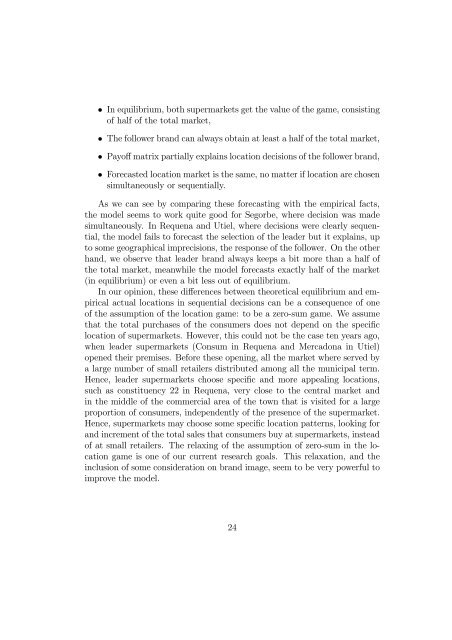Download PDF - Ivie
You also want an ePaper? Increase the reach of your titles
YUMPU automatically turns print PDFs into web optimized ePapers that Google loves.
• In equilibrium, both supermarkets get the value of the game, consisting<br />
of half of the total market,<br />
• The follower brand can always obtain at least a half of the total market,<br />
• Payoff matrix partially explains location decisions of the follower brand,<br />
• Forecasted location market is the same, no matter if location are chosen<br />
simultaneously or sequentially.<br />
As we can see by comparing these forecasting with the empirical facts,<br />
the model seems to work quite good for Segorbe, where decision was made<br />
simultaneously. In Requena and Utiel, where decisions were clearly sequential,<br />
the model fails to forecast the selection of the leader but it explains, up<br />
to some geographical imprecisions, the response of the follower. On the other<br />
hand, we observe that leader brand always keeps a bit more than a half of<br />
the total market, meanwhile the model forecasts exactly half of the market<br />
(in equilibrium) or even a bit less out of equilibrium.<br />
In our opinion, these differences between theoretical equilibrium and empirical<br />
actual locations in sequential decisions can be a consequence of one<br />
of the assumption of the location game: to be a zero-sum game. We assume<br />
that the total purchases of the consumers does not depend on the specific<br />
location of supermarkets. However, this could not be the case ten years ago,<br />
when leader supermarkets (Consum in Requena and Mercadona in Utiel)<br />
opened their premises. Before these opening, all the market where served by<br />
a large number of small retailers distributed among all the municipal term.<br />
Hence, leader supermarkets choose specific and more appealing locations,<br />
such as constituency 22 in Requena, very close to the central market and<br />
in the middle of the commercial area of the town that is visited for a large<br />
proportion of consumers, independently of the presence of the supermarket.<br />
Hence, supermarkets may choose some specific location patterns, looking for<br />
and increment of the total sales that consumers buy at supermarkets, instead<br />
of at small retailers. The relaxing of the assumption of zero-sum in the location<br />
game is one of our current research goals. This relaxation, and the<br />
inclusion of some consideration on brand image, seem to be very powerful to<br />
improve the model.<br />
24
















